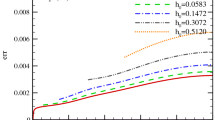Abstract
A known difficulty with using the Clauser chart method to determine the friction velocity in wall bounded flows is that it assumes, a priori, a logarithmic law for the mean velocity profile. Using both experimental and DNS data in the literature, this note explicitly shows how friction velocities obtained using the Clauser chart method can potentially mask subtle Reynolds-number-dependent behavior.







Similar content being viewed by others
References
Barenblatt GI, Chorin AJ (1998) Scaling of the intermediate region in wall-bounded turbulence: the power law. Phys Fluids 10:1043–1044
Bradshaw P, Huang GP (1995) The law of the wall in turbulent flow. Proc R Soc Lond A 451:165–188
Clauser FH (1956) The turbulent boundary layer. Adv Appl Mech 4:1–51
Fernholz HH, Finley PJ (1996) The incompressible zero-pressure-gradient turbulent boundary layer: an assessment of the data. Prog Aerospace Sci 32:245–311
George WK, Castillo L (1997) Zero-pressure-gradient turbulent boundary layer. Appl Mech Rev 50:689–729
Moser RD, Kim J, Mansour NN (1999) Direct numerical simulation of turbulent channel flow up to Re τ =590. Phys Fluids 11:943–945
Patel VC, Head MR (1969) Some observations on skin friction and velocity profiles in fully developed pipe and channel flow. J Fluid Mech 38:181–201
Purtell LP, Klebanoff PS, Buckley FT (1981) Turbulent boundary layer at low Reynolds number. Phys Fluids 24:802–811
Zagarola MV, Perry AE, Smits AJ (1997) Log laws or power laws: the scaling in the overlap region. Phys Fluids 9:2094–2100
Zanoun E, Durst F, Nagib H (2003) Evaluating the law of the wall in two-dimensional fully developed turbulent channel flows. Phys Fluids 15:3079–3089
Author information
Authors and Affiliations
Corresponding author
Rights and permissions
About this article
Cite this article
Wei, T., Schmidt, R. & McMurtry, P. Comment on the Clauser chart method for determining the friction velocity. Exp Fluids 38, 695–699 (2005). https://doi.org/10.1007/s00348-005-0934-3
Received:
Revised:
Accepted:
Published:
Issue Date:
DOI: https://doi.org/10.1007/s00348-005-0934-3




